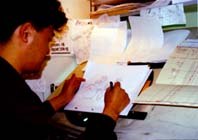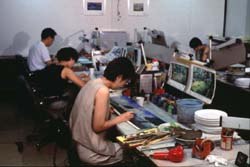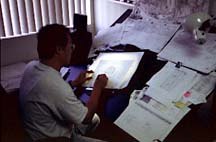Milt Vallas reports on Korea's growth from humble beginnings to big business. This Asian dynamo is striving to be taken seriously by the international animation community.

Over the last ten years the animation industry in South Korea has grown beyond what had to have been the wildest dreams of its early pioneers. Today, South Korea is undoubtedly the largest supplier of television animation in the world. Industry estimates are not always precise, but no one would argue that in peak production years the country's production houses can turn out over a thousand half-hour (22 minute) episodes. While some may argue about the quality of overseas animation, no one has ever turned out the quantity of work to compare to this Asian dynamo. How did this all come about and how did the Korean animation industry grow into this 5,000 pound gorilla? What does the future look like for this high flying industry? Let's see.
In the Beginning...
Exactly how this all started depends, like many things, on who you ask. In 1960 two men, Mr. Dong Heon Shin and Mr. Chung produced a 6-minute animated short for AFKN (Armed Forces Korean Network) titled I am Water. This small educational film might be called the Genesis of Korean Animation.

In the following years some work came into the country from Japan but this was almost exclusively ink and paint work. One of the early companies working with Japan was TBC, a broadcasting company which no longer exists. TBC is credited with performing assistant animation on a show titled Golden Bat.
In 1968 a company, International Art Production, began re-doing a series of single reel shows featuring classic animation characters such as Betty Boop, Krazy Kat, Felix and even Porky Pig. These old theatrical shorts were being copied frame by frame and being reproduced in color. This company was run by Mr. Jeong Yoon Song and Mr. Tayk Kim.
Several years later in 1973, the same Mr. Kim would hook up with Steve Hahn and open Dong Seo Animation. Dong Seo is important because it will morph into HanHo which will become a major player in the formative years of Korean animation. However, in 1973, Korean animation was still just beginning and mostly limited to ink and paint work from Japan. Dong Seo Animation broke ground by joining up with Ralph Bakshi and supplying in-between animation on features War Wizards and Hey Good Looking.

In the early years, the Korean animation industry was a bit rough and tumble. The Korean business culture was not always well understood by Westerners and in turn, Korean producers did not always understand their Western clients. Steve Hahn came to be seen by many as the epitome of the tough Korean producer. Hahn's style was more direct and confrontational than other studios in the region, such as those in Taiwan or Japan, where saving face and avoidance of open conflict was a more natural way of dealing with problems. The Koreans were the New Yorkers of Asia. They worked hard, played hard and didn't pull any punches both literally and figuratively. When it came to face, Korean style was more in your face. They fought equally among themselves with partnerships quickly forming, exploding apart and reforming all over Seoul. This highly competitive and volatile business atmosphere began to form in 1979-80 when Steve Hahn opened his new company, MiHahn. He received work from Ruby-Spears on their show Plastic Man. This work came to him with the help of Jerry Smith, who was trusted by Joe Ruby and Ken Spears. Smith had been sent to Taiwan by Bill Hanna in 1978 to help James Wang set up Cuckoos Nest, but, in what would become a reoccurring theme, he had a falling out there and so was ready to try a new start up in 1980 with Steve Hahn in South Korea.
At the same time, Nelson Shin, another key figure in the story, was starting out and began by making a deal with Depatie-Freleng to bring six half-hours of a show they were producing with The Netherlands to Korea. The show was titled Dr. Snuggle. In 1979, Nelson also brought a Bugs Bunny special for Depatie-Freeling to Korea. Nelson Shin believes he brought the first full show (animation through camera) to Seoul. Others feel Steve Hahn or the late Jerry Smith was first. All in all, it doesn't really matter, as they were all pioneers and helped to get the industry started. By 1985, the animation industry had become firmly established in Seoul. Jerry Smith had split with Steve Hahn, formed his own company, Take One, closed it and then left the country. Mr. Tayk Kim had left Dong Seo and started his own company called Pion Animation and Nelson Shin was opening a new studio, AKOM, which would eventually become the largest in Korea. Steve Hahn was about to lose his studio, then HanHo, by producing Starchaser, a 3-D theatrical film which would flop and result in his financial backers taking over his studio. If there is a marked beginning to Korea's golden period, it had to be in the mid to late Eighties when animation studios began popping up all over Seoul; Daiwon, Sei Young, AKOM and Saerom, to name a few, were all formed during this period.

How Do They Do It?
To start with, everyone works very hard. Secondly, the studios in Seoul, and there are well over sixty studios listed there alone, have developed a system that relies upon a strong cottage industry for many phases of production. Anywhere from ink and paint to camera, there's someone out there who wants to sub-contract your work if you'll give it to them. Also, almost everyone freelances, or moonlights if you like, and many studios lay off work like a bookie lays off bets when he gets more action than he can handle. A studio may be producing three separate series at the same time and not even have a layout department in house; it will all be freelanced out.
While this might be undesirable for an overseas supervisor who wants to see his work come back to him in a smooth flow, this system helps the studios in that it provides decentralized micro-management within each phase of production supplied by each contractor, not dissimilar from the way Boeing manufactures its airplane. The larger studios producing the pricey shows maintain full in-studio departments but even they will avail themselves to freelance help when they need it. The bottom line is that over the past fifteen years, Seoul has developed a large and capable work force and a system in which their production efforts can be maximized when needed and downsized when slow. Overseas Supervisors For those not familiar with the term, this refers to the client's representative, sent by the client, and normally at his expense, to work within the contracting studio. This person most often is an artist (layout, animator, designer or even a director), but they could also be a production manager type. The first Westerners who went over to Asia were all very versatile artists who worked with the local staff as instructors as much as client watchdogs. What the Korean animators didn't know is that these people taught them. American animation employed and still employs, different techniques, style and timing than Japanese animation. These early supervisors helped the studios to speed up the learning curve, enabling them to understand quickly how to produce acceptable work for the Western market.

The Business Men
Another interesting phenomenon of the Korean animation industry is the relatively large number of studio owners who have no particular interest in animation other than as an investment. These are men and women who have acquired their companies as business enterprises but have no more attachment to their studios than to their plumbing supply house or import/export companies. These business owners often buy into animation studios that need a cash infusion and, more often than not, end up taking over the company from its original owner. There has also been a trend to form studio groups with one large studio taking smaller studios under its wing and presenting the group as one large holding. A most recent example of this was the Rainbow Animation Studio group (more recently renamed to Galaxy World, Inc.) which was put together by Ted Choi, a Korean business man who lives in Los Angeles and came from the garment business. This system is simply an extension of subcontracting but with the logical twist of doing it openly and telling the client that you own/have control of the smaller studios doing their work. The only problem is that often times, the group is made up of totally separate business entities, with completely different agendas, and the studio doing your work is not being paid a fee that will allow them to produce a solid show. The group is only held together by the main studio's ability to supply everyone shows at a reasonable fee. After a while, inevitably, the small studios grow unhappy with the large studio from which they receive work. The large studio naturally skims a percentage of the client's fees and the studio doing the work feels unappreciated and underpaid. Also, if the show is successful, the large studio takes the bows and egos can be fragile things.

The New Studios and the `90s Boom
Like all businesses, success breeds competition, and there is nowhere more competitive when it comes to business than Asia. The `90s saw a rash of new studios enter the scene.
Disney Television brought its shows to a new, bright and aggressive studio called Sun Woo. In 1991, Michael Webster, who was then in charge of production for Disney Television Animation, told me that Sun Woo was producing some of the best work he had ever seen and that Disney was so impressed with the quality, they were putting them under an exclusive contract. This didn't work out for long, as Disney wanted exclusivity and Sun Woo wasn't prepared to be tied down in such a growing market. Rough Draft Korea (RDK) started by doing an odd little show called Ren and Stimpy and soon were being sought after as a highly creative studio capable of producing the off-the-wall type productions that Klasky-Csupo and Nickelodeon were developing as their benchmarks. Plus One, Koko (formerly Dong Yang), a revitalized Saerom and Daiwon, along with an ever-expanding AKOM, led the charge into the Nineties with Korea capturing up to 30% of the world market in animation production. From 1990 to 1996 the business has grown with last year reaching an all time high. AKOM alone reported a production run of 189 shows for the year. The little industry that started so quietly in 1968 with an educational film has grown into a major industry which by 1996 probably came close to grossing $120 million US.
So What's Next?
Building a market and keeping it are two different things. It doesn't take a Wharton school grad to understand that if the demand for new animated programming slows, so does the industry that produces the shows. 1997 is a definite down tick from 1996, but as 1997 was such a record year, the comparison may be unfair. There is still a healthy number of shows being produced throughout Asia and certainly a good number of these are in South Korea. The question that every studio owner must ask is how long will the good times roll? At the end of last year, a friend who is the head of production for a major studio went to Korea to look for a production house to place a new series that was to start this year. Her company is not known for having high budgets, but the new project was well-funded, so she thought she would interview a few high end studios, who she hadn't been able to use before. When she arrived in Seoul her appointments were rather brusquely canceled. She was told it would be a waste of time for her to go to the studios as she couldn't afford them. "I couldn't believe how arrogant they were," she told me. This year both studios would be honored to bid on her work. I asked Nelson Shin about what he saw in the future for AKOM and the industry in general. His response was guarded but generally optimistic. Nelson feels that the industry is still in excellent shape but he does understand that not all years will be banner ones like 1996. Nelson is one of the founders. He has seen bad times before and knows that the industry can turn south rather quickly. However, he feels confident in his own ability to bring work into AKOM and keep his staff busy. He also feels that maintaining a high quality standard and a good reputation will help the strong studios survive through the off-years.
I also discussed the popularity of animation in Seoul with Tayk Kim. He pointed out that there were now five different animation festivals being held in Seoul this year alone. Mr. Kim, like Nelson Shin, is optimistic but also cautious. It seems that all of the producers I have talked with feel that they need to find a way to develop strong properties in which they can share long term revenues. This is not easy, as we all know. The Koreans seem to be exploring different avenues. Animation houses are trying to link up with post-production houses in order to offer Western producers a fuller package that can help shows with tight budgets. Korean layout and storyboard artists have set up small production units in Los Angeles which bid on shows as an entire package, again trying to present themselves as attractively as possible.
Korean television, KBS 1 and 2, MBC and SBS, cannot pay for quality original programming. Sometimes a Korean studio will take a Korean broadcast license on a Western show as part of their fee, however, the value is not as great as the discount they offer. The Korean market is simply too small for the broadcasters to cough up a substantial amount of dollars. These "co-production" deals are often no more than sales gimmicks offered to make the client feel that the studio has a vested interest in the show, and will favor it in production over the other shows simultaneously going through the studio. Most often this is not true and the discount or back end position that the studio takes is worth little or nothing to them in reality. The catch here is that the studio has promised to provide a production service at a certain level of quality and to accept a lesser payment than they would normally charge for that service. Seemingly, the studio takes an ownership position in the show in proportion to the difference in services provided and lesser payment received. The rub for the client is that the studio may elect to produce the show at the exact same level of quality as the payment they've received; not at the higher level promised. Some producers like Nelson Shin are encouraging young artistic staff members to try to develop the next Aeon Flux property as Korean designer Peter Chung did. They know that until they can demand a slice of the pie that they bake for the Western producers, they will continue to deal with the peaks and valleys of subcontracting. Shin, who is President of Korea's ASIFA chapter, believes that there is a great deal of talent in Korea that is still untapped. He would like to see Koreans more involved in the creation of programs but he understands that the main foundation of his industry is in the subcontracting domain.
Photo courtesy of Galaxy World. Photo courtesy of HanHo Company Ltd.
As more U.S. productions are being produced electronically, the Korean studios are responding by expanding their digital facilities.
One other note, North Korea has joined the South in the animation industry. SEK is a state owned and operated animation studio in North Korea with a staff of 500 people. We haven't heard too much about this company in the U.S. up until now, and we couldn't do business with them legally, but the French can and do. Currently this studio is producing 26 half-hours a year at a very competitive price for European producers. I suspect that it may not be long before political differences are put aside and business interests are addressed between the two Koreas.
Closing Thoughts
It seems that Korean animation is in the same or better position than U.S. animation. As long as someone is buying new television shows, Korea will continue to be called upon to produce them. The Korean producers also have Europe to look to for work, and potentially interesting relationships, should the U.S. and Canadian market slow up. After 30 years in this business, I've learned that nothing stays the same, but I think the Korean industry is still very strong and most importantly, flexible enough to weather a few off-years should they come along.
Milt Vallas is an independent producer who is known as a specialist in overseas animation production.







